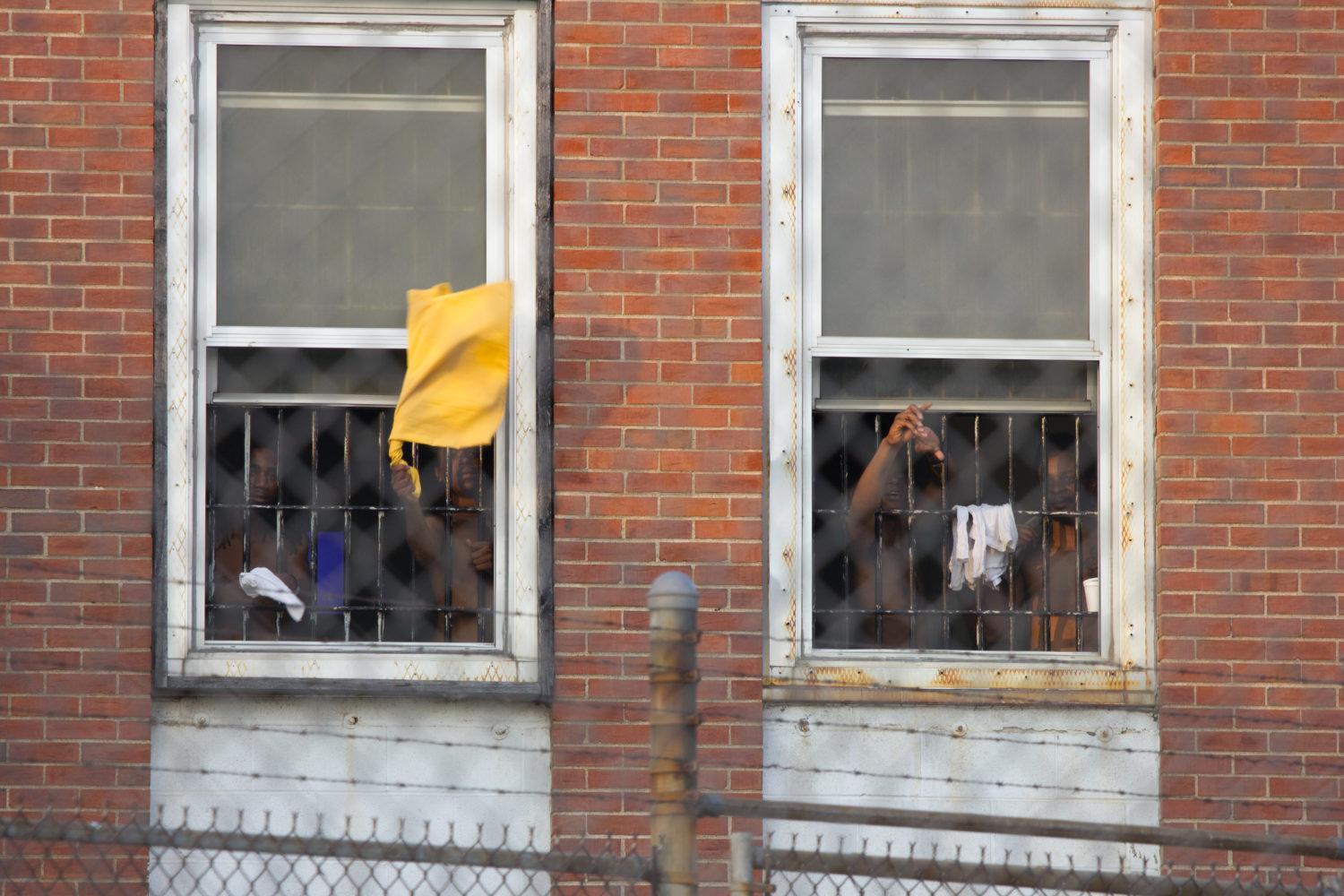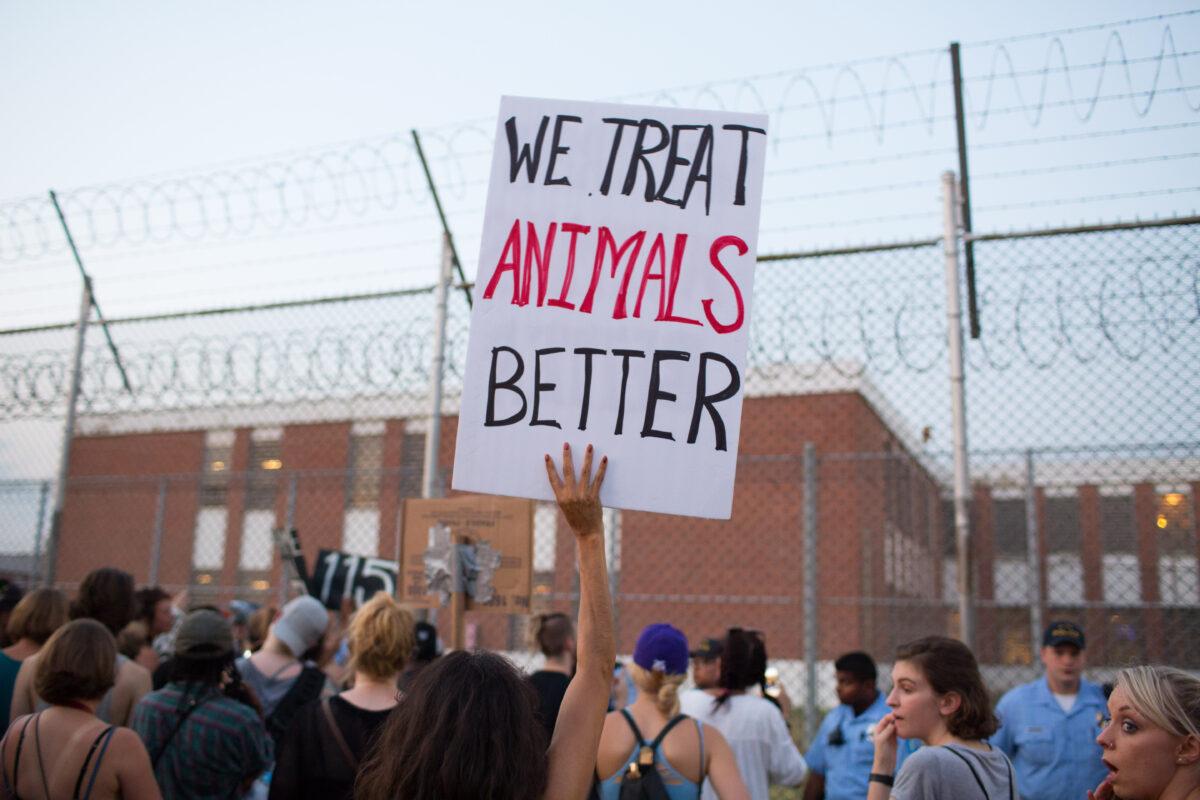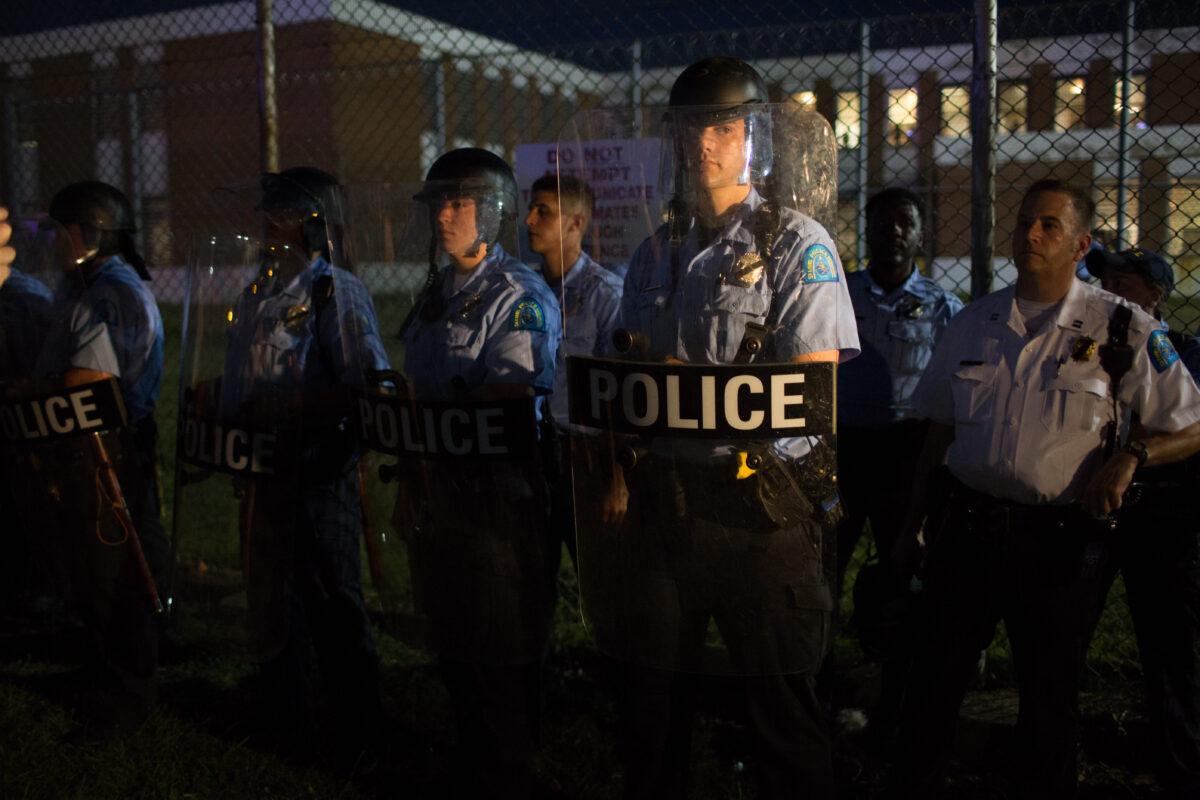‘You Never Want to go to the Workhouse’
Activists launch a new campaign to close an infamous St. Louis jail.

Two rows of barbed wire fencing can’t block the screams that escape from behind the barred windows at the jail. “Help us!” the men shout from inside. The sweltering sun beams down on the two-story brick building, heating its cells. “Let us out!” they beg. “We ain’t got no AC!”
Their pleas were immortalized when Elliot Davis, a Fox2Now reporter, captured the moment on video last summer. The clip was widely circulated, igniting protests outside the St. Louis Medium Security Institution, also known as “the Workhouse.” Demonstrators faced pepper spray as they demanded air conditioning for prisoners left to roast in triple-digit temperatures during a dangerous heatwave. The protests and political pressure proved successful as city officials arranged for temporary, portable air conditioning units to be installed in portions of the jail, though there is still no permanent fix.
Community organizers say the lack of air conditioning was only one of the facility’s many problems, which have sparked complaints for years but have been routinely ignored. But the activists say they have had enough. Since last July, the jail’s conditions have been the subject of numerous protests, complaints, a lawsuit, and now a new campaign calling for its closure. ArchCity Defenders, a nonprofit law firm; Missourians Organizing for Reform and Empowerment, a nonprofit, nonpartisan, social justice organization; Saint Louis Action Council, a Black-led, multiracial activists collective; and The Bail Project, a national revolving bail fund, have together launched a new campaign called Close the Workhouse. They say the facility is inhumane and disproportionately incarcerates poor people and people of color who can’t afford to post bail.
“In St. Louis, everybody knows about the Workhouse,” says Inez Bordeaux, 37, a lead organizer in the campaign. “Everybody knows at least one person who’s been there, so we’ve all heard the stories about how bad it is.” The stories, she acknowledges, were not atypical for American jails: food not fit for animals and callous guards. Bordeaux says it wasn’t until she spent 30 days in the facility on a probation violation, unable to afford bail, that she realized, “It’s so much worse than everything that I have ever heard.”

Built in 1966, the Workhouse is one of two jails in St. Louis, and holds prisoners accused of less serious crimes. It can hold 1,138 people, and has an annual budget of around $16 million. In March, it housed 557 prisoners, according to the city Department of Public Safety’s monthly report. The jail’s nickname is said to come from an 1848 city ordinance ordering prisoners who could not pay their fines to be committed to the “Work House” to pay off their debts.
Nearly all the people held at the Workhouse have not been convicted of crimes; they are awaiting trial, and most cannot afford to post bail in the interim. There are seven times more Black detainees than there are white detainees, although only 47 percent of St. Louis’s population is Black.
The Workhouse is not new to scrutiny. In 2007, the Eastern Missouri branch of the American Civil Liberties Union investigated both St. Louis jails, and released a report detailing squalid conditions, policy violations, overcrowding, negligence, staff assaults on detainees, and systematic cover-up of incidents by staff and administrators.
Now, a decade later, ArchCity Defenders say many of the same problems persist. The firm has filed a federal lawsuit against the city alleging that conditions in the Workhouse are inhumane and violate prisoners’ civil rights. “On any given day, detainees in the jail must endure infestations of rats, snakes, cockroaches, and other insects; extreme temperatures ranging from stifling heat in the summers to frigid cold in the winters; inconsistent and inadequate provision of medical care and mental health treatment; poor air quality and proliferation of mold caused by the jail’s lack of ventilation and inadequate sanitation; overcrowding; insufficient staffing; and a culture of fear created by frequent violence and retaliation, including by jail staff,” it states.
Bordeaux says the lawsuit makes sense. “You’re not even treated with basic human decency,” she said. For her, the most dehumanizing incident came when a guard told her to roll up toilet paper as a makeshift sanitary napkin when supplies reportedly ran out. The slightest protest, she says, meant being locked in her cell for a day to teach her a lesson. “No one should have to deal with that. There’s nothing decent about the Workhouse,” said Bordeaux. “It’s a truly desperate place.”
Last year, state Representative Joshua Peters (D-St. Louis), whose district is home to the Workhouse, organized a bipartisan tour of the jail after receiving letters from his constituents complaining about its conditions. He concluded that some of St. Louis’s “poorest citizens are doomed to a hellish existence” while confined there pretrial. Echoing other Missourians, Peters says the Workhouse has loomed over the community for decades. “Since I was a little child, I remember people saying, ‘You never want to go to the Workhouse.’ It was the worst jail in the metropolitan area in the city of St. Louis.”
He said he witnessed sewage leaking from toilets and that the jail’s kitchen reeked of the stench of mold buildup. Prisoners had to take their food back to their dorms. One prisoner yelled he had been bitten by a rodent, lifting his pant leg to reveal a gaping hole. The prison also showed signs of structural damage in need of repair, Peters said. “I noticed that one of the cells, there may have been about 50 men who were in the infirmary waiting to be seen by a doctor; they only had one doctor on staff and one nurse’s aide.”

Corrections Commissioner Dale Glass and Public Safety Director Jimmie Edwards said complaints of inhumane conditions were false and in March of this year invited members of the media into the jail, where a correspondent for Fox2News reported that “inmates appeared as content as one could be in a jail.” Edwards agreed the facility was old, but said it was functional. “We take great pride in making sure that it’s clean, that the inmates are treated humanely,” Glass said in an interview with the station. The commissioner did not respond to The Appeal’s requests for comment.
In addition to the jail conditions, lawyers and organizers say too many people spend too much time in the jail for minor offenses because they can’t afford bail. “The court is setting bail so high that people who are poor and do not have the money to pay it, are being incarcerated pretrial even though a significant number of the cases are resulting in dismissals by the state or not-guilty verdicts,” said Mary Fox, lead public defender in St. Louis. It’s not uncommon for her clients to be held on $1,000 bail and be required to pay 10 percent down, but unable to come up with the $100. Even more typically, Fox’s clients are held on $5,000 bail, making it impossible for them to come up with the 10 percent needed to get out.
Bordeaux was one of the hundreds of detainees unable to afford bail. While on probation for overdrawing on unemployment benefits, she was detained for failing to report to her probation officer and held in the Workhouse, with bail set at $25,000. Bordeaux, who had been living in transitional housing, says she didn’t have the 10 percent that was due; $2,500 was more than her monthly salary at that time. She waited, and on the 30th day, the judge released her. “So, I basically sat there 30 days for nothing.”
Fox says her office isn’t receiving evidence about her clients in a timely manner, which prolongs their jail stays. In April, she filed a petition for a writ of mandamus claiming that Circuit Attorney Kim Gardner’s prosecutors have been consistently violating a Missouri Supreme Court rule requiring the “timely” disclosure of evidence. Gardner’s office is seeking a dismissal of that complaint. “We just want them to follow the rules,” Fox told The Appeal. The St. Louis public defender’s office is overloaded with cases, she said, and poor people are waiting for representation, which means pretrial detainees who can’t afford bail sit in jail even longer.
Organizers want the circuit attorney to do more than release evidence; they want her to stop locking people up for being poor and to follow through on her campaign promises. In 2017, with the support of social justice progressives, Gardner became St. Louis’s first Black circuit attorney, sending a wave of hope through the city. While some activists are still optimistic about her potential, others are disappointed that she hasn’t done more.
“She keeps sending people to the Workhouse. It’s her office that keeps requesting these high bails … it’s her!” Bordeaux said. “If she wanted to, she could literally decide to just stop sending people to the Workhouse … stop demanding these high, high bails that keep people locked up in the Workhouse, but she hasn’t done that.”
Kayla Reed of the St. Louis Action Council agreed that Gardner’s tenure has been disappointing. “What we’re hopeful for is that she’s been reflective of that and is making adjustments.” Her recent decision to dismiss some low-level drug possession cases is a good sign, Reed said. “Perhaps it’s her saying, ‘I feel comfortable in my position, I’m going to do more.’”
In a statement, Gardner said reducing incarceration rates is essential to creating a fairer criminal justice system in St. Louis. “People should not linger in jail simply because they are poor,” she wrote. “Being held in jail, even just for a few days, can have a devastating impact on a person’s life.” She says she has already undertaken the “enormous task” of reforming aspects of the criminal justice system she can influence and has partnered with organizations including the Vera Institute of Justice to research the use of bail and possible reforms. She plans to announce new changes within the next two months.
Meanwhile, the Close the Workhouse campaign plans to hold its first big action in the next few weeks, calling for community reinvestment, the closure of the facility and decarceration in general. The organizers want to see a complete overhaul of the way the circuit attorney asks for bail, including the use of more precharge diversion programs for nonviolent crimes like trespassing, shoplifting and panhandling.
“The city is spending all this money on a failing jail when there’s really no reason to keep any of these folks locked up pretrial,” says Janos Marton, a consultant on the campaign, who formerly managed the #CLOSErikers campaign for JustLeadershipUSA. Marton sees some parallels between the two campaigns, which he says are fueled by the energy of directly impacted people.
“In both cases,” he said, “there is no argument that the jails are working, only a lack of imagination from certain elected officials about how to reduce the number of people they are jailing.”
